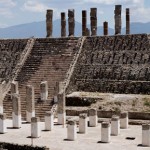by Jack Kornfield: Examining Buddhist notions of identity and selflessness…
Spiritual practice inevitably brings us face to face with the profound mystery of our own identity. We have taken birth in a human body. What is this force that gives us life, that brings us and the world into form? The world’s great spiritual teachings tell us over and over we are not who we think we are. But does that mean there is no self or a search for true self?
Persian mystics say we are sparks of the divine, and Christian mystics say we are filled with God. We are one with all things, say others. The world is all illusion, say others. Some teachings explain how consciousness creates life to express all possibilities, to be able to love, to know oneself. Others point out how consciousness gets lost in its patterns, loses its way, incarnates out of ignorance. Hindu yogas call the world a lila, or a dance of the divine, much like Dante’s phrase, “the divine comedy.”
Buddhist texts describe how consciousness itself creates the world like a dream or a mirage. Modern accounts of near-death experiences are filled with reports of wonderful ease after leaving the body, of golden light and luminous beings. Perhaps these, too, confirm how we are unaware of our true identity most of the time.
When we look into the question of self and identity in spiritual practice, we find it requires us to understand two distinct dimensions of no self and true self.
When the Buddha confronted the question of identity on the night of his enlightenment, he came to the radical discovery that we do not exist as separate beings. He saw into the human tendency to identify with a limited sense of existence. Then he discovered that this belief in an individual small self is a root illusion. It causes suffering and removes us from the freedom and mystery of life. He described this as interdependent arising, the cyclical process of consciousness creating identity by entering form, responding to contact of the senses, then attaching to certain forms, feelings, desires, images, and actions to create a sense of self.
WHO CREATED THE SELF?
In teaching, the Buddha never spoke of humans as persons existing in some fixed or static way. Instead, he described us as a collection of five changing processes: the processes of the physical body, of feelings, of perceptions, of responses, and of the flow of consciousness that experiences them all. Our sense of self arises whenever we grasp at or identify with these patterns. The process of identification, of selecting patterns to call “I,” “me,” “myself,” is subtle and usually hidden from our awareness. We can identify with our body, feelings, or thoughts; we can identify with images, patterns, roles, and archetypes.
Thus, in our culture, we might fix and identify with the role of being a woman or a man, a parent or a child. We might take our family history, our genetics, and our heredity to be who we are. Sometimes we identify with our desires: sexual, aesthetic, or spiritual. In the same way we can focus on our intellect or take our astrological sign as an identity. We can choose the archetype of hero, lover, mother, ne’er-do-well, adventurer, clown, or thief as our identity and live a year or a whole lifetime based on that. To the extent that we grasp these false identities, we continually have to protect and defend ourselves, strive to fulfill what is limited or deficient in them, to fear their loss.
Yet, these are not our true identity. One master with whom I studied used to laugh at how easily and commonly we would grasp at new identities. As for his non-self, he would say, “I am none of that. I am not this body, so I was never born and will never die. I am nothing and I am everything. Your identities make all your problems. Discover what is beyond them, the delight of the timeless, the deathless.”
DIFFERENT KINDS OF SELF
Because the question of identity and selflessness is subject to confusion and misunderstanding, let us go into it more carefully. When Christian texts speak of losing the self in God, when Taoists and Hindus speak of merging with a True Self beyond all identity, when Buddhists speak of emptiness and of no self, what do they mean? Emptiness does not mean that things don’t exist, nor does “no self” mean that we don’t exist. Emptiness refers to the underlying nonseparation of life and the fertile ground of energy that gives rise to all forms of life. Our world and sense of self is a play of patterns.
Any identity we can grasp is transient, tentative. This is difficult to understand from words such as selflessness or emptiness of self. In fact, my own teacher Achaan Chah said, “If you try to understand it intellectually, your head will probably explode.” However, the experience of no self in practice can bring us to great freedom.
Deep meditation can untangle the sense of identity. There are, in fact, many ways in which we can realize the emptiness of self. When we are silent and attentive, we can sense directly how we can never truly possess anything in the world. Clearly we do not possess outer things. We are in some relationship with our cars, our home, our family, our jobs, but whatever that relationship is, it is “ours” only for a short time. In the end, things, people, or tasks die or change or we lose them. Nothing is exempt.
WE OWN NOTHING
When we bring attention to any moment of experience, we discover that we do not possess it either. As we look, we find that we neither invite our thoughts nor own them. We might even wish them to stop, but our thoughts seem to think themselves, arising and passing according to their nature.
The same is true of our feelings. How many of us believe we control our feelings? As we pay attention, we see that they are more like the weather-moods and feelings change according to certain conditions, and are neither possessed nor directed by our consciousness or desires. Do we order happiness, sadness, irritation, excitement, or restlessness to come? Feelings arise by themselves, as the breath breathes itself, as sounds sound themselves.
Our body, too, follows its own laws. The body which we carry is a bag of bones and fluid that belong to no one. It ages, gets sick, or changes in ways we might not wish it to, all according to its own nature. The more we look, in fact, the more deeply we see that we possess nothing within or without.
EVERYTHING FROM NOTHING
We encounter another aspect of the emptiness of self when we notice how everything arises out of nothing, comes out of the void, returns to the void, goes back to nothing. All our words of the past day have disappeared. Similarly, where has the past week or the past month or our childhood gone? They arose, did a little dance, and now they’ve vanished, along with the 1980s, the nineteenth and eighteenth centuries, the ancient Romans and Greeks, the Pharaohs, and so forth. All experience arises in the present, does its dance, and disappears. Experience comes into being only tentatively, for a little time in a certain form; then that form ends and a new form replaces it moment by moment.
In meditation, precise and deep attention shows us emptiness everywhere. Whatever sensation, thought, whatever aspect of body of mind we focus on carefully, the more space and the less solidity we experience there. Experience becomes like the particle waves described in modern physics, a pattern not quite solid, ever-changing. Even the sense of the one who is observing changes in the same way, our perspectives shifting from moment to moment as much as our sense of ourselves shifts from childhood to adolescence to old age. Wherever we focus carefully, we find a veneer of solidity that dissolves under our attention.
DISCOVER INTERCONNECTEDNESS
The real world is beyond our thoughts and ideas; we see it through the net of our desires, divided into pleasure and pain, right and wrong, inner and outer. To see the universe as it is, you must step beyond the net. It is not hard to do so, for the net is full of holes — Sri Nisargadatta
As we open and empty ourselves, we come to experience an interconnectedness, the realization that all things are joined and conditioned in an interdependent arising. Each experience and event contains all others. The teacher depends on the student, the airplane depends on the sky.
When a bell rings, is it the bell we hear, the air, the sound on our cars, or is it our brain that rings? It is all of these things. As the Taoists say, “The between is ringing.” The sound of the bell is here to he heard everywhere—in the eyes of every person we meet, in every tree and insect, in every breath we take…
When we truly sense this interconnectedness and the emptiness out of which all beings arise, we find liberation and a spacious joy. Discovering emptiness brings a lightness of heart, flexibility, and an ease that rests in all things. The more solidly we grasp our identity, the more solid our problems become. Once I asked a delightful old Sri Lankan meditation master to teach me the essence of Buddhism. He just laughed and said three times, “No self, no problem.”
NO SELF IS NOT APATHY
Misconceptions about “no self” and emptiness abound. And such confusions undermine genuine spiritual development. Some people believe that they can come to selflessness by struggling to get rid of their ego-centered self. Others confuse the notion of emptiness with inner feelings of apathy, unworthiness, or meaninglessness that they have carried from a painful past into spiritual practice. Some students use emptiness as an excuse for a withdrawal from life, saying it is all illusion, trying to make a “spiritual bypass” around life’s problems. But each of these diseases of emptiness misses the true meaning of emptiness and its liberating freedom.
To try to get rid of the self, to purify, root out, or transcend all desire, anger, and centeredness, to vanquish a self that is “bad,” is an old religious idea. This notion underlies the ascetic practices, such as wearing hair shirts, extreme fasting, and self-mortification, that are found in many traditions. Sometimes such practices are used skillfully, to induce altered states, but more often they only reinforce aversion
Worse, what comes with them is the notion that our body, our mind, our “ego,” is somehow sinful, dirty, and deluded. “I (the good part of me) must use these techniques to get rid of the self (the lower, bad part of me).” But this can never work. It can never work because there is no self to get rid of! We are a changing process, not a fixed being. There never was a self-only our identification makes us think so. So while purification, kindness, and attention can certainly improve our habits, no amount of self-denial or self-torture can rid us of a self, for it was never there.










































